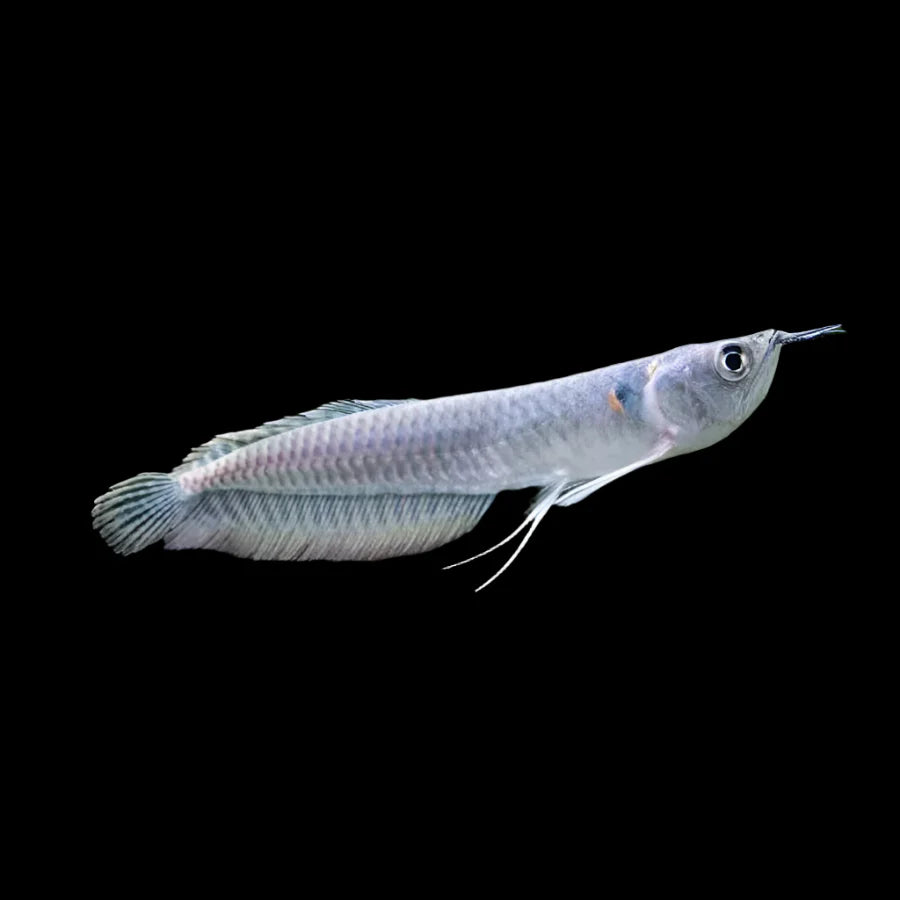Description
Silver Arowana – Majestic Surface Predator of the Amazon
(Osteoglossum bicirrhosum)
The Silver Arowana (Osteoglossum bicirrhosum) is one of the most iconic and awe-inspiring freshwater fish in the hobby. Originating from the Amazon Basin, this surface-dwelling predator is admired for its metallic silver sheen, long, slender body, and graceful, gliding movements. With a prehistoric lineage and powerful presence, the Silver Arowana is a true centerpiece fish—ideal for experienced aquarists with large tanks.
Key Features:
-
Striking Appearance: Sleek silver body, elongated fins, and distinctive upturned mouth
-
Impressive Size: Can reach up to 90 cm (36 inches) in captivity
-
Surface Hunter: Known for leaping to catch insects and small animals above water
-
Prehistoric Elegance: One of the oldest living lineages of freshwater fish
Tank Requirements:
-
Minimum tank size: 500 liters (125+ gallons); larger for adults
-
Temperature: 24°C–28°C (75°F–82°F)
-
pH: 6.5–7.5
-
Requires a long, wide tank with a tight-fitting lid (they are powerful jumpers)
-
Decorate minimally with driftwood or rocks to ensure open swimming space
Compatibility:
-
Semi-aggressive—can be kept with other large, robust fish such as Oscars, large catfish, or bichirs
-
Will eat any tankmates small enough to fit in its mouth
-
Not recommended for community tanks with small or peaceful fish
Feeding Tips:
-
Carnivorous—feeds on live or frozen foods such as shrimp, fish, insects, and worms
-
Can be trained to accept pellets, especially high-protein floating varieties
-
Feed once daily, avoiding overfeeding to maintain water quality
Why Choose the Silver Arowana?
The Silver Arowana is a breathtaking addition to any large aquarium, offering both visual impact and a glimpse into evolutionary history. Its powerful presence and graceful demeanor make it a favorite among advanced hobbyists seeking a truly iconic showpiece.
Click & Collect
Livestock will only be bagged once you arrive, or if you contact us in advance to request it ready beforehand.
Local Delivery
Order anything from our in-store range and have it delivered right to you.
-
Minimum spend: £50
-
Delivery up to 10 miles: £10
-
Delivery up to 25 miles: £20
Distances are measured “as the crow flies”, not by road.
Once your order is placed, we’ll be in touch to arrange a suitable delivery date and time.
Please note, delivery may take a little longer as we often group orders together to build an efficient delivery run.
Important: If you’re ordering a large aquarium, please ensure someone is available to help unload the van on arrival.
Dry Goods Delivery
-
DX Express: 1 working day, same-day dispatch before noon 0-75kg
-
Express Pallet: 1–3 working days 75-500kg
If you'd like to add more items to an existing order that hasn't yet been dispatched, please place a Click & Collect order and leave a note asking us to combine the orders.
Please note: We currently only dispatch parcels Wednesday to Friday.
Pre-Order
Want the full details? Check out our Terms & Conditions.
Livestock Delivery
Thursday Delivery – £24
-
Dispatched Wednesday afternoon
-
Delivered Thursday before 1pm
-
Order by Wednesday 12 noon
-
Minimum spend: £50
Friday Delivery – £24
-
Dispatched Thursday afternoon
-
Delivered Friday before 1pm
-
Order by Thursday 12 noon
-
Minimum spend: £50
Saturday Delivery – £29
-
Dispatched Friday afternoon
-
Delivered Saturday before 1pm
-
Order by Friday 12 noon
-
Minimum spend: £50
📦 Want to Add to an Existing Order?
No problem! Just place a Click & Collect order and leave a note asking us to link it with your original one (as long as it hasn’t been dispatched yet).
🛒 Dry Goods Now Included!
You can now include dry goods in your livestock delivery – perfect for topping up supplies in one go.
❄️ Please note: We can’t send frozen food with livestock – please order frozen items separately.
⚠️ Delivery Exclusions
Unfortunately, we’re unable to deliver livestock to the following postcodes:
Scotland & Isles:
AB30–AB56, DD8–DD10, DG3–DG9, DG12–DG14, FK17–FK21, KA18–KA19, KA26–KA30, PA20–PA38, PA80, PH3–PH40
Cornwall Isles: TR21–TR25
All of the following postcodes are excluded:
BT, HS, IM, IV, JE, KW
Plus Channel Islands and Shetland Islands
Payment & Security
Your payment information is processed securely. We do not store credit card details nor have access to your credit card information.

